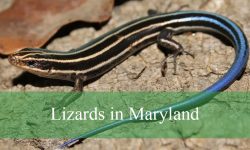Arizona is a birdwatcher’s paradise, offering a diverse range of habitats from deserts and canyons to mountains and riparian areas. This variety attracts an incredible array of bird species, making the state a hotspot for both casual observers and dedicated ornithologists.
From the vivid colors of hummingbirds and Vermilion Flycatchers to the stealthy presence of owls and hawks, Arizona’s birdlife is as fascinating as it is diverse. Many species are residents year-round, while others migrate through the state, offering seasonal highlights for birdwatchers.
This guide covers 46 common birds in Arizona, featuring detailed identification tips, key characteristics, and fun facts. Exploring backyards, parks, or natural reserves in Arizona has never been easier for spotting and appreciating these remarkable birds.
Most Common Birds Found in Arizona
Cactus Wren
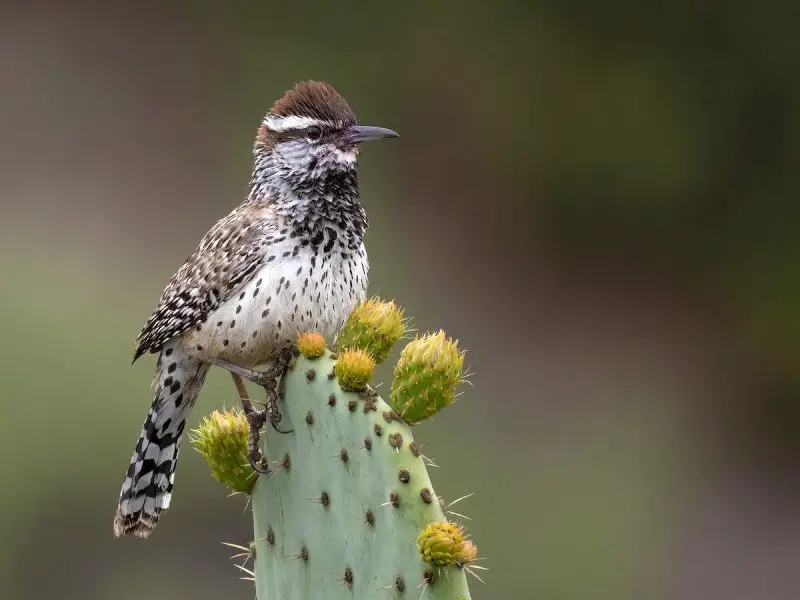
The Cactus Wren is Arizona’s official state bird and a true symbol of the desert. It is the largest wren in North America, measuring about 7–9 inches long, with bold white eyebrows, brown-streaked plumage, and a slightly curved bill. Its long tail and spotted breast make it easy to identify among desert shrubs.
This hardy bird thrives in arid environments, often nesting inside cholla or prickly pear cacti for protection. They are year-round residents across Arizona’s deserts, frequently spotted hopping around saguaros, mesquite, and agave while foraging for insects, spiders, and seeds. Unlike many other wrens, they are not shy and often explore near homes and gardens.
A fascinating fact about Cactus Wrens is their elaborate nest-building behavior. Pairs construct large, football-shaped nests of twigs in thorny plants, not only for raising young but also as roosting shelters year-round. Their raspy, chugging song is another distinctive feature of the Arizona desert soundscape.
Northern Cardinal
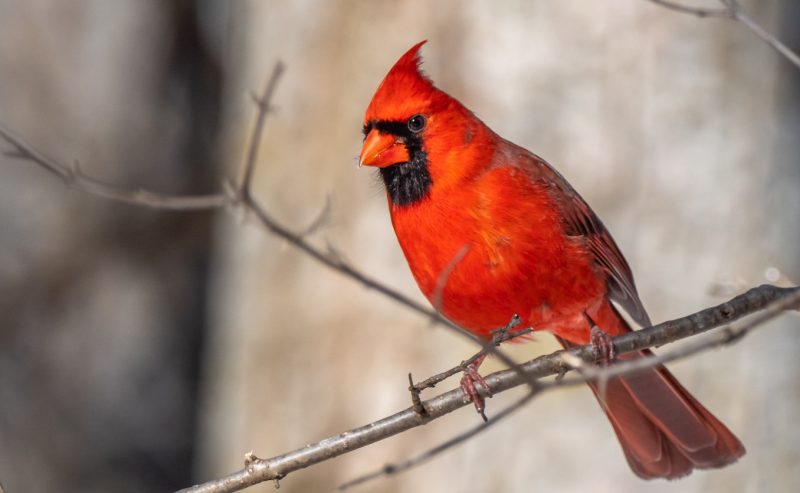
The Northern Cardinal is one of the most striking birds in Arizona, easily recognized by its vivid red plumage in males and warm brown tones with red highlights in females. Its crest and black facial mask make it unmistakable, even from a distance. These medium-sized songbirds measure around 8–9 inches in length and are often seen perched in trees, shrubs, and backyard feeders.
In Arizona, Northern Cardinals are most commonly found in riparian woodlands, desert edges, and suburban areas with thick vegetation. They are year-round residents, preferring habitats that offer cover and a steady supply of seeds, fruits, and insects. Their rich, whistled songs are often heard at dawn and dusk, bringing a cheerful sound to the desert landscape.
A fun fact about Northern Cardinals is that they are monogamous and fiercely protective of their territories. Males are often seen attacking their own reflections, mistaking them for rivals. Their brilliant plumage and melodious calls have also made them one of the most beloved backyard birds across the United States.
House Finch
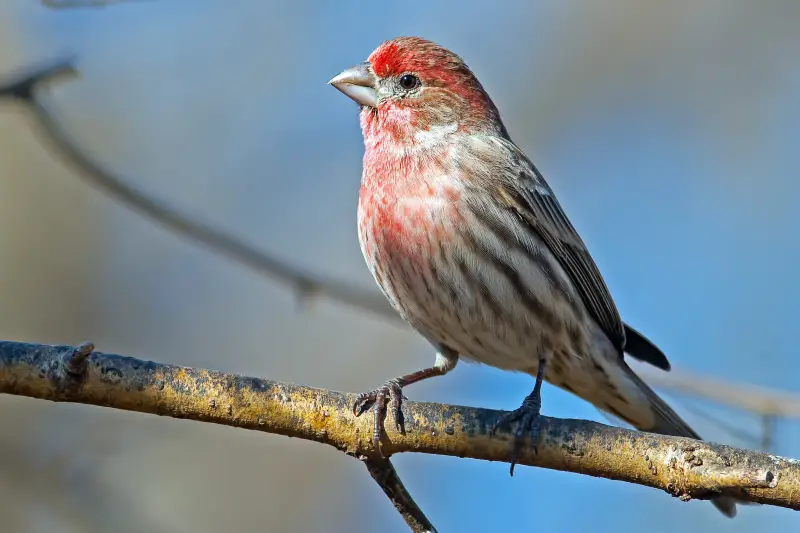
The House Finch is a small, colorful bird that thrives in Arizona’s varied habitats. Males are easily identified by their red-streaked heads and chests, while females are more subdued in brown and white streaking. They measure about 5–6 inches long and have a conical bill adapted for seed eating, making them frequent visitors to bird feeders.
These finches are highly adaptable and can be found in deserts, forests, grasslands, and urban areas throughout Arizona. They feed primarily on seeds, fruits, and occasionally insects, often foraging in flocks. Their cheerful, warbling song is a familiar sound in both wild and suburban environments, especially around neighborhoods with bird feeders.
An interesting fact about House Finches is that their red coloration is influenced by their diet. Males with more access to carotenoid-rich foods, such as berries, display brighter red plumage, which females prefer when choosing a mate. This makes diet directly tied to their success in reproduction.
Mourning Dove
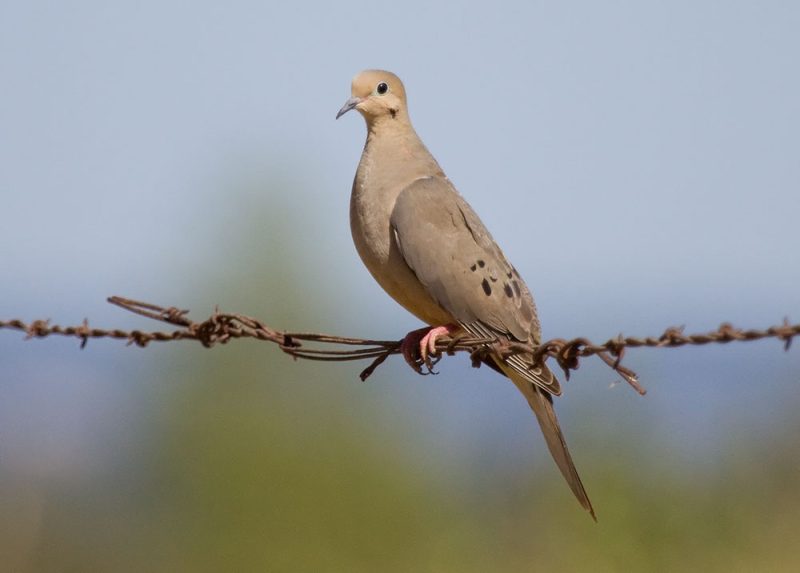
The Mourning Dove is one of Arizona’s most widespread and familiar birds, known for its soft, mournful cooing that gives the species its name. Slender-bodied with long, pointed tails, these doves are light brown to gray with black spots on their wings. They measure about 9–13 inches in length and have rapid, whistling wingbeats when taking flight.
These doves thrive in open habitats such as deserts, grasslands, agricultural fields, and urban areas. In Arizona, they are year-round residents, often seen perched on wires, fences, or foraging on the ground for seeds. They are prolific breeders, raising multiple broods in a season, especially in warm climates like Arizona.
A fun fact about Mourning Doves is their incredible flight speed, which can reach up to 55 miles per hour. They are also one of the most hunted game birds in North America, yet their population remains stable thanks to their adaptability and high reproductive rate.
White-winged Dove
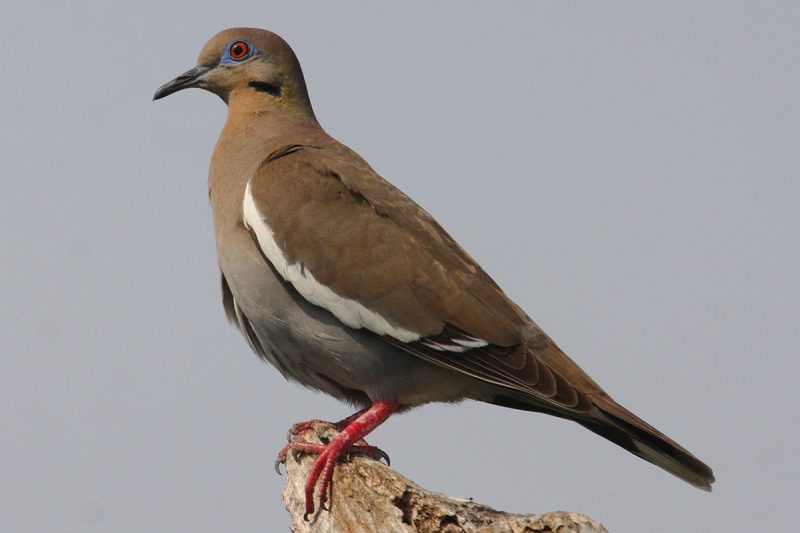
The White-winged Dove is a large, elegant dove that is particularly abundant in southern Arizona. It is easy to identify by the bold white stripe along its folded wings and the blue skin surrounding its red eyes. Measuring about 11 inches long, this bird has a sturdy body and a strong, direct flight pattern.
These doves are closely tied to desert habitats, especially where saguaro cacti are present. In fact, they play an essential role in pollinating saguaros when they feed on the nectar of cactus flowers. During summer, they migrate into Arizona in large numbers to breed, taking advantage of the desert’s seasonal abundance.
A fascinating fact about White-winged Doves is that they are capable of long migrations, with some populations traveling over 1,000 miles. In Arizona, their arrival is often seen as a sign of summer, and their distinctive “who-cooks-for-you” call echoes through desert landscapes.
Eurasian Collared-Dove

The Eurasian Collared-Dove is a non-native species that has rapidly expanded across Arizona in recent decades. It is recognized by its pale gray plumage, black collar on the back of its neck, and squared-off tail. Larger than a Mourning Dove, it measures about 12 inches in length and often gathers in groups around food sources.
Originally introduced to the Bahamas in the 1970s, this species quickly spread across North America and is now a common resident in Arizona. They are especially abundant in towns, farms, and suburban neighborhoods, where they feed on seeds, grains, and backyard bird feeders. Their cooing call, a distinct three-part sound, is often heard throughout the year.
A fun fact about Eurasian Collared-Doves is their remarkable expansion speed. Within just a few decades, they colonized almost the entire continental United States, making them one of the fastest-spreading bird species in modern history. Despite being non-native, they coexist with other dove species in Arizona.
Gambel’s Quail
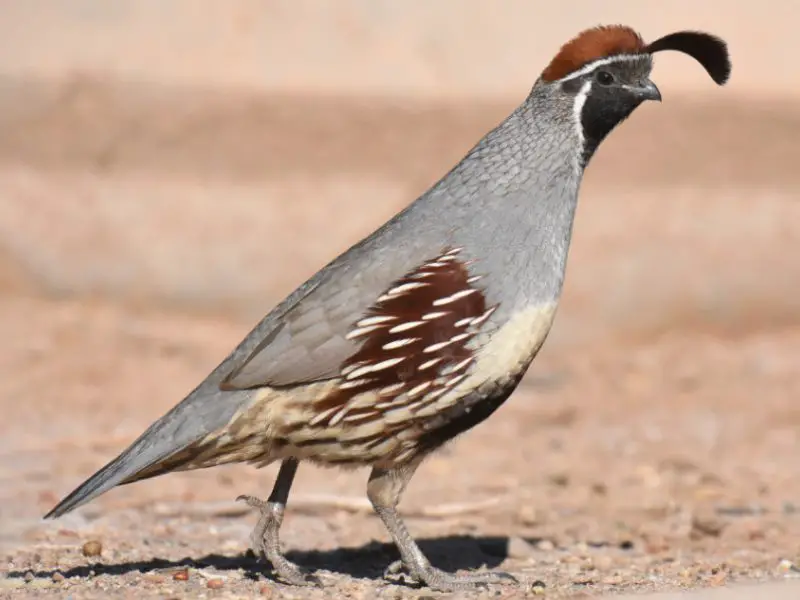
Gambel’s Quail is one of the most iconic desert birds of Arizona, instantly recognizable by the forward-facing black plume that curves over its head. These plump, round-bodied birds are about 9–11 inches long, with gray plumage, chestnut sides, and scaled patterns on their bellies. Males have a bold black face outlined in white, making them stand out in a covey.
They prefer desert scrub, mesquite thickets, and arid grasslands, often seen scurrying across roads or hiding under shrubs. These ground-dwelling birds feed on seeds, fruits, and insects, rarely flying unless threatened. In Arizona, they are year-round residents and are commonly observed in family groups called coveys, especially near water sources.
A fascinating fact about Gambel’s Quail is their social nature. They are often seen traveling in groups, communicating with a distinctive “ka-KAA-ka” call. During spring, their adorable chicks, which look like tiny cotton balls, can be spotted running after their parents in neat little lines.
Curve-billed Thrasher
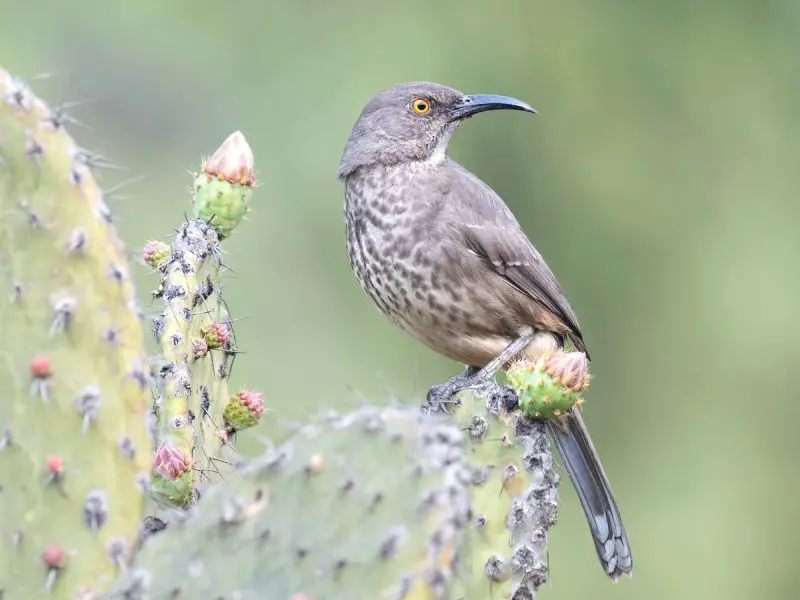
The Curve-billed Thrasher is a medium-sized bird known for its long, downward-curved bill and striking orange eyes. Measuring about 10–12 inches in length, it has grayish-brown plumage with faint spots on the chest. This bill is perfectly adapted for digging into soil and leaf litter to uncover insects and seeds, giving the bird its name.
In Arizona, Curve-billed Thrashers are common residents of desert scrublands, mesquite thickets, and neighborhoods with cactus gardens. They are particularly associated with cholla cacti, where they often build their nests for protection from predators. Their loud, sharp “whit-wheet” call is one of the most familiar sounds of the desert.
A fun fact about this species is its remarkable vocal ability. Like other thrashers, the Curve-billed Thrasher can mimic the calls of other birds, though it often sticks to a varied, melodious song. Their adaptability to urban areas has made them frequent visitors to backyards in Arizona.
Gila Woodpecker
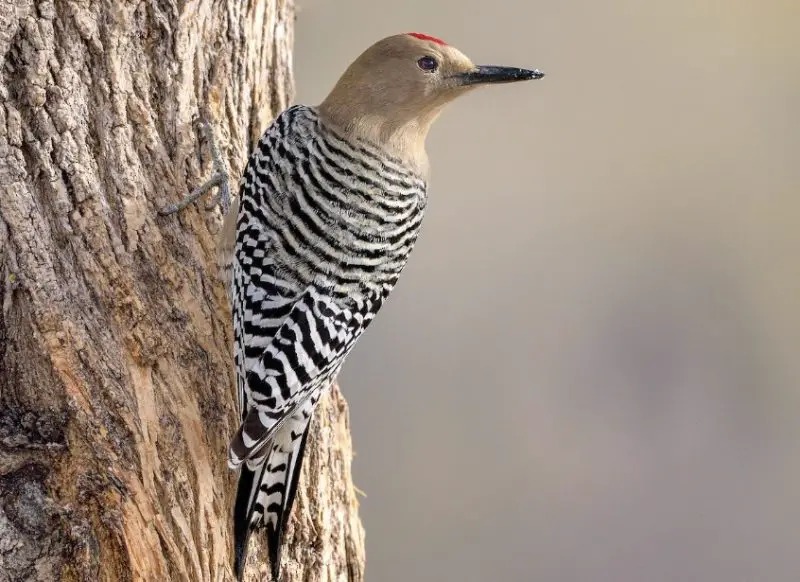
The Gila Woodpecker is a striking desert woodpecker, recognized by its black-and-white barred back and tan head. Males have a small red patch on the crown, while females lack this marking. They are medium-sized woodpeckers, reaching 9–10 inches in length, and have a strong, chisel-like bill used for drilling into trees and cacti.
In Arizona, Gila Woodpeckers are especially associated with saguaro cacti, where they excavate nest cavities. These cavities are later used by other species such as Elf Owls and Purple Martins, making the Gila Woodpecker a keystone species in the desert ecosystem. They also feed on insects, fruits, berries, and even nectar from hummingbird feeders.
A fun fact about Gila Woodpeckers is that they have adapted to desert life so well that they often use saguaro cavities not only for nesting but also for storing food. The cactus provides insulation from the scorching heat, keeping their young safe during Arizona’s hottest months.
Gilded Flicker
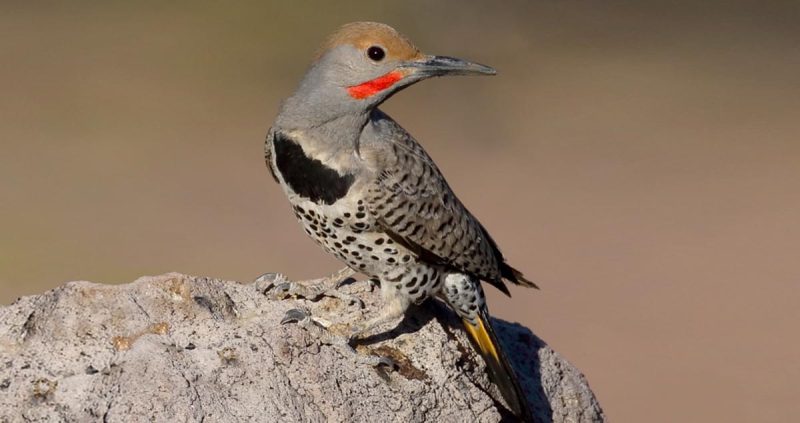
The Gilded Flicker is a large woodpecker native to the deserts of Arizona, particularly the Sonoran Desert. It is closely related to the Northern Flicker but distinguished by its golden underwings and tail feathers. Measuring 11–12 inches long, it has a brown body with black bars on the back and a black crescent on the chest.
This bird relies heavily on saguaro cacti, where it excavates nesting holes. Like other flickers, it spends much of its time on the ground, searching for ants and beetles, which make up a large part of its diet. In Arizona, it is most often seen in desert flats and cactus-rich landscapes.
A fascinating fact about the Gilded Flicker is its role in creating homes for other wildlife. The nesting holes it drills into saguaros are later used by a wide variety of desert birds, reptiles, and even mammals. Its presence is a clear indicator of a healthy desert ecosystem.
Ladder-backed Woodpecker

The Ladder-backed Woodpecker is a small, agile woodpecker, measuring only 6–7 inches in length. It is identified by the black-and-white “ladder” pattern on its back and its white underparts streaked with black. Males have a red crown, while females display a plain black cap. Its sharp bill is used to probe into wood for insects.
In Arizona, this woodpecker favors desert scrub, mesquite groves, and areas with scattered cacti. Unlike larger woodpeckers, it thrives in dry, open landscapes, where it feeds on ants, beetles, and larvae found beneath bark. They also occasionally visit backyard feeders for suet or fruit.
A fun fact about Ladder-backed Woodpeckers is that they are remarkably acrobatic, often hanging upside down or clinging to the sides of cactus stalks while foraging. Their ability to survive in harsh desert conditions makes them one of the most resilient woodpeckers in North America.
Verdin
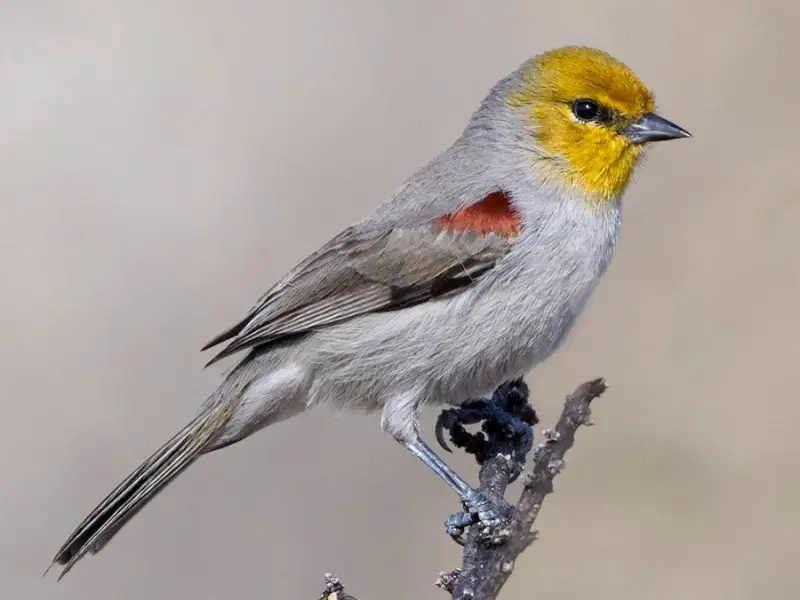
The Verdin is a tiny desert bird, measuring only about 4.5 inches in length, making it one of the smallest songbirds in Arizona. Despite its size, it is easy to identify by its gray body, small pointed bill, and bright yellow head. It also has chestnut-colored shoulder patches visible in flight.
This bird thrives in hot, arid desert scrub, mesquite trees, and thorny shrubs, where it feeds on insects, spiders, and nectar. Verdins are year-round residents of Arizona’s deserts, often darting quickly through branches in search of food. They also supplement their diet with fruit and will visit hummingbird feeders.
A fun fact about Verdins is their nest-building habit. They construct multiple large, spherical nests of twigs throughout the year, not only for breeding but also as roosting shelters in both summer and winter. This behavior helps them survive Arizona’s extreme desert temperatures.
Northern Mockingbird

The Northern Mockingbird is one of the most well-known songbirds in Arizona, admired for its exceptional ability to mimic the calls of other birds. Medium in size at about 9–11 inches long, it has a slender gray body, long legs, and distinctive white wing patches that flash during flight. Its long tail, often flicked up and down, is another key field mark.
This bird thrives in a variety of habitats, including deserts, open woodlands, urban parks, and residential neighborhoods. In Arizona, it is a year-round resident that adapts well to human presence, often singing from rooftops, fences, and utility poles. It feeds on insects, berries, and fruits, making it an important part of the ecosystem.
A fun fact about the Northern Mockingbird is that a single individual can learn and perform over 200 different songs. They are also fiercely territorial, often chasing away much larger birds to defend their nesting area. Their constant singing, both day and night, is a defining sound of Arizona’s warm evenings.
Anna’s Hummingbird

Anna’s Hummingbird is one of the most vibrant hummingbirds in Arizona, recognized by the dazzling rose-pink crown and throat of adult males. Females and juveniles are more subdued, with gray-green plumage and some red spotting on the throat. These small birds measure about 4 inches in length but make up for their size with remarkable energy.
They are common in Arizona’s urban areas, gardens, and desert habitats where flowering plants are abundant. Unlike many other hummingbird species, Anna’s Hummingbirds are year-round residents in much of Arizona, sustained by feeders and native blossoms. Their diet consists of nectar, small insects, and spiders for protein.
A fascinating fact about Anna’s Hummingbird is its unique courtship display. Males perform dramatic dives from heights of up to 130 feet, producing a loud, sharp sound with their tail feathers as they swoop down in front of females. This spectacular display is one of the most impressive in the hummingbird world.
Costa’s Hummingbird
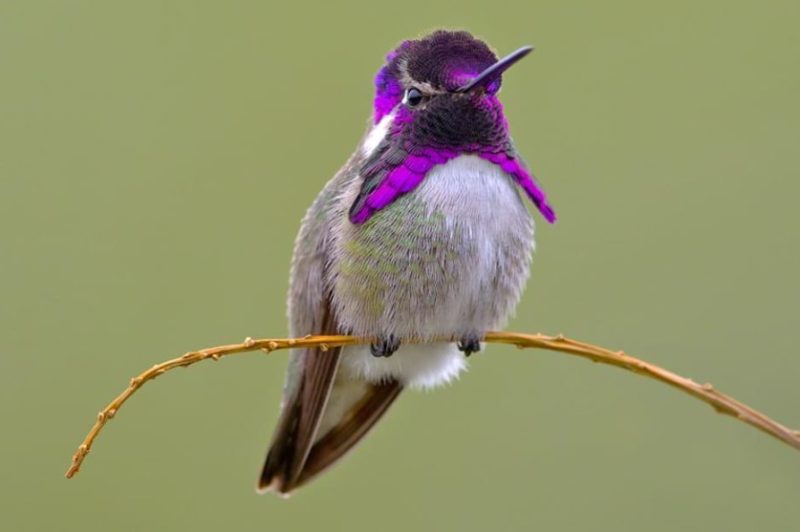
Costa’s Hummingbird is a true desert specialist, recognized by the brilliant violet-purple crown and long throat feathers of the males. These glittering feathers flare out during courtship, creating a striking display. Females are mostly greenish-gray with pale underparts and subtle hints of purple. At about 3.5 inches long, it is one of the smaller hummingbirds in Arizona.
This species thrives in arid regions, desert scrub, and areas with flowering cacti and shrubs. In Arizona, Costa’s Hummingbirds are most commonly seen in the southern deserts, where they nest in spring and early summer. They feed primarily on nectar but also take small insects to balance their diet.
A fun fact about Costa’s Hummingbird is its ability to survive in harsh desert conditions. Unlike many other hummingbirds that migrate long distances, Costa’s can remain year-round in the Southwest, perfectly adapted to the dry climate and desert blooms.
Black-chinned Hummingbird

The Black-chinned Hummingbird is a widespread and adaptable species in Arizona. Males have a distinctive black throat with a thin strip of iridescent purple at the base, visible in good light, while females are plain greenish-gray. They measure around 3.5–4 inches long and are slender with a relatively long bill.
These hummingbirds breed in riparian woodlands, desert scrub, and suburban areas throughout Arizona. They are more common in the warmer months, often visiting backyard feeders and flowering plants from spring through fall. Their diet consists of nectar, small insects, and spiders, which provide essential protein.
A fun fact about the Black-chinned Hummingbird is that it has one of the fastest wingbeat-to-heart rate ratios of any bird. Its wings beat about 50 times per second, and its heart rate can reach up to 1,200 beats per minute, allowing it to hover effortlessly while feeding.
Broad-billed Hummingbird
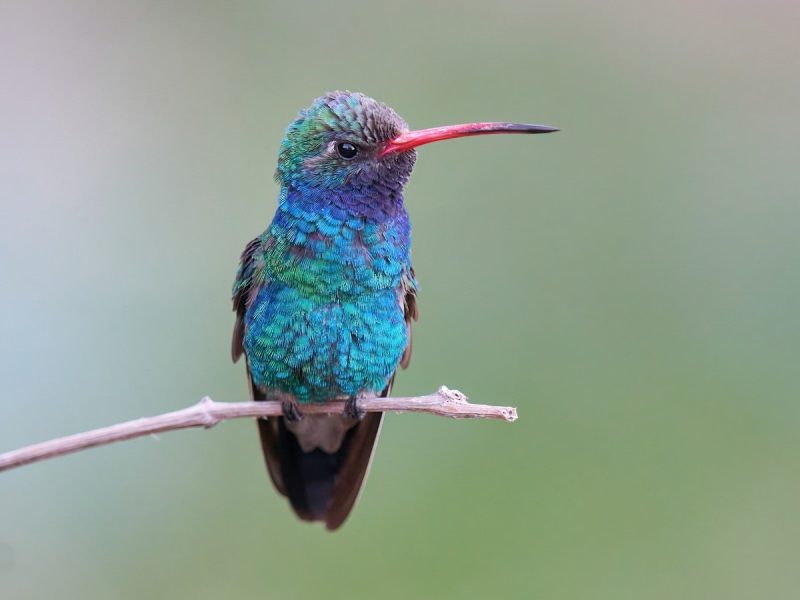
The Broad-billed Hummingbird is a stunning bird of Arizona’s southern regions, easily identified by its bright blue-green plumage and vivid orange-red bill with a black tip. Males are especially vibrant, while females are more subdued with grayish undersides and a slightly curved bill. They measure about 4 inches in length.
This species is most common in southeastern Arizona, particularly in canyons, desert foothills, and areas rich in flowering plants. They are seasonal visitors, usually appearing in spring and summer to breed. Their energetic hovering and frequent trips to feeders make them a favorite among bird enthusiasts.
A fun fact about Broad-billed Hummingbirds is that they are known to be bold and aggressive despite their small size. Males often chase away other hummingbirds from feeding territories, making them one of the most dominant species at Arizona feeders.
Violet-crowned Hummingbird
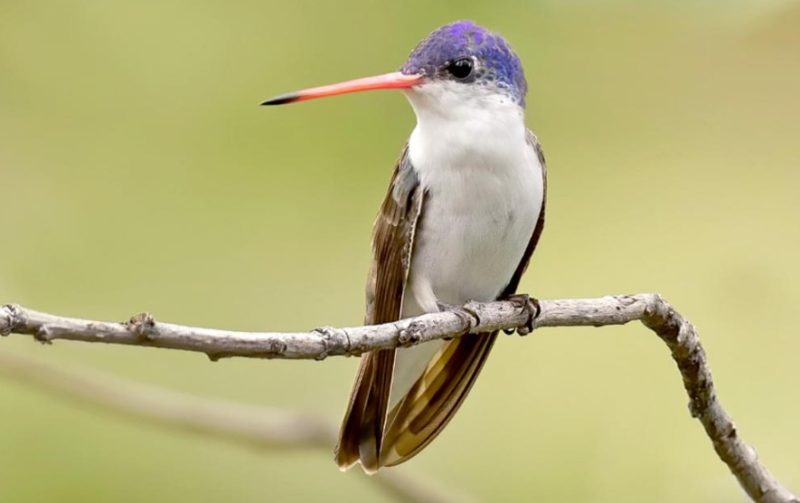
The Violet-crowned Hummingbird is a rare but spectacular visitor to Arizona, known for its pure white underparts, green back, and striking violet-blue crown. Its straight, bright orange-red bill is another distinguishing feature. Measuring about 4.5 inches long, it is slightly larger than many other hummingbirds in the region.
In Arizona, this species is mostly limited to the southeastern corner, especially in riparian habitats and canyons near the Mexican border. It is more frequently seen during the summer months when flowers and feeders provide abundant food sources. Its diet, like other hummingbirds, consists of nectar and small insects.
A fun fact about the Violet-crowned Hummingbird is that it is one of the few hummingbirds with an all-white underside, making it easy to spot compared to the more colorful, iridescent species. Its rarity in Arizona makes every sighting a special event for birdwatchers.
Broad-tailed Hummingbird
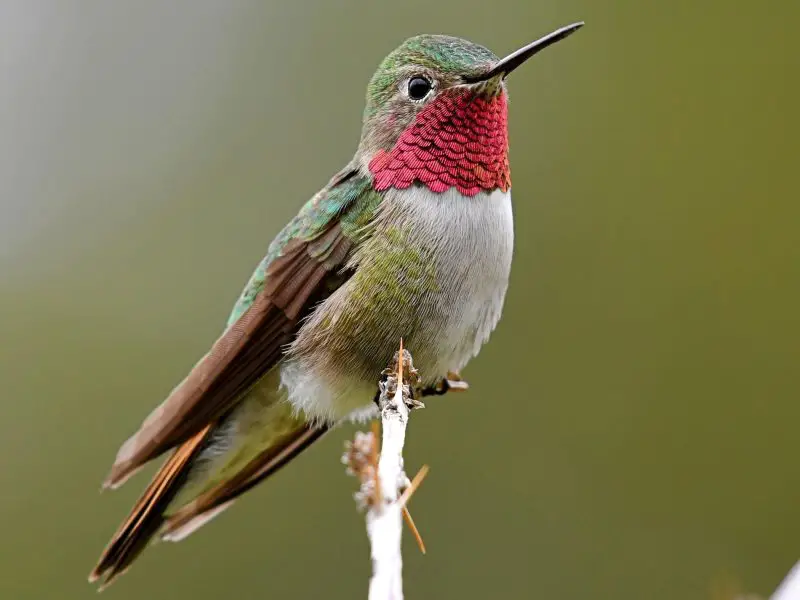
The Broad-tailed Hummingbird is a medium-sized species, measuring about 4 inches long, with iridescent green plumage and a rose-red throat patch in males. Females and juveniles are less colorful, showing green backs and pale undersides with spots along the throat. Their long wings create a distinctive trilling sound during flight, which makes them easy to identify even when not seen clearly.
This species is most often found in Arizona’s mountain meadows, pine-oak woodlands, and high-elevation forests during the summer breeding season. They migrate from Mexico and Central America to the southwestern United States each spring, feeding on nectar from wildflowers and small insects for protein. Broad-tailed Hummingbirds are especially common around blooming meadows and mountain streams.
A fun fact about this bird is that it has remarkable cold-weather survival skills. At night in high-elevation habitats, it enters a state of torpor to conserve energy, lowering its body temperature dramatically to withstand chilly mountain nights.
Great Horned Owl
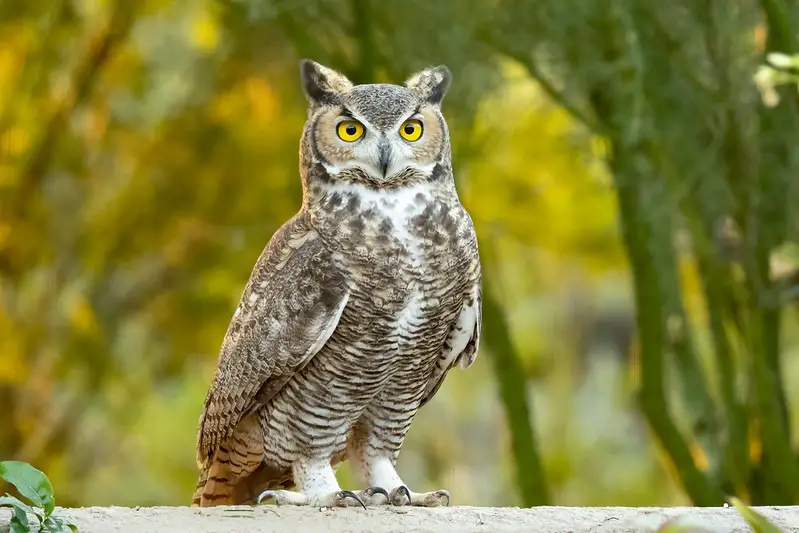
The Great Horned Owl is one of the largest and most powerful raptors in Arizona. Easily recognized by its tufted “horns” or ear tufts, it has mottled brown plumage, piercing yellow eyes, and a wingspan of up to 5 feet. Adults typically measure 18–25 inches long and weigh up to 3.5 pounds, making them formidable hunters.
This owl thrives in a wide range of habitats across Arizona, from deserts and forests to urban parks and agricultural fields. It is a year-round resident and often nests in abandoned hawk nests, cliff ledges, or large trees. Nocturnal by nature, it hunts rabbits, rodents, reptiles, and even other birds, making it one of the top avian predators in the state.
A fun fact about the Great Horned Owl is its incredibly powerful grip. Its talons can exert pressure of up to 500 pounds per square inch, strong enough to crush the spine of its prey instantly. This makes it one of the most fearsome hunters in North America.
Western Screech-Owl
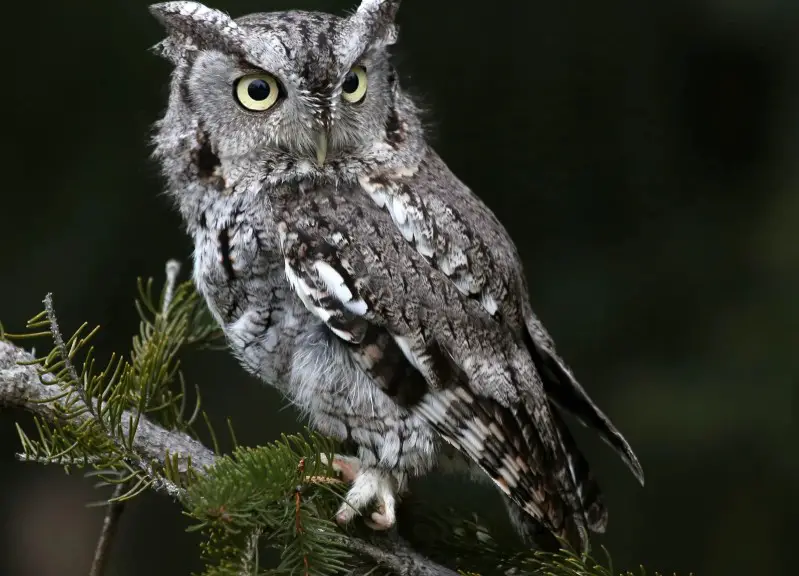
The Western Screech-Owl is a small, stocky owl that measures about 8–10 inches long with a wingspan of around 2 feet. Its plumage is a mix of gray and brown, patterned with streaks that provide excellent camouflage against tree bark. The small ear tufts and yellow eyes make it a charming but often overlooked resident of Arizona’s landscapes.
These owls inhabit deserts, riparian woodlands, and suburban areas throughout Arizona. They nest in tree cavities, old woodpecker holes, or even nest boxes placed in backyards. Their diet includes insects, small mammals, birds, and reptiles. They are most active at night, when their soft trilling or bouncing calls can be heard.
A fun fact about the Western Screech-Owl is that despite its name, it doesn’t actually screech. Instead, it produces a series of whistles or short hoots, making its call sound more melodic than alarming.
Elf Owl
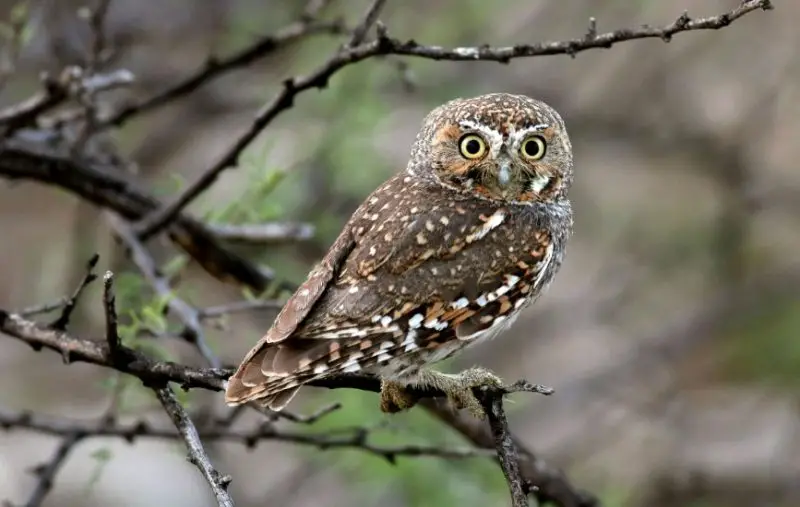
The Elf Owl holds the title of the world’s smallest owl, measuring just 5–6 inches in length and weighing less than 2 ounces. It has pale gray-brown plumage, yellow eyes, and a round head without ear tufts. Its tiny size and soft coloration make it difficult to spot, even when perched in open areas.
In Arizona, Elf Owls are found mainly in the southern deserts, where they nest in old woodpecker holes within saguaros or mesquite trees. They are nocturnal insect-eaters, feeding on moths, beetles, scorpions, and other small invertebrates. These owls migrate to Mexico in the winter and return to Arizona in spring to breed.
A fun fact about Elf Owls is their surprising boldness despite their size. When threatened, they often play dead or emit high-pitched cries to confuse predators. Birdwatchers treasure sightings of Elf Owls since they are both elusive and enchanting.
Burrowing Owl

The Burrowing Owl is a small, long-legged owl that stands out for its unusual behavior of living underground. Adults measure about 9–10 inches long, with sandy-brown plumage spotted with white, bright yellow eyes, and no ear tufts. Their upright stance and habit of perching near burrow entrances make them distinctive.
In Arizona, they are commonly found in open grasslands, deserts, and agricultural fields, often using burrows dug by prairie dogs or ground squirrels. Unlike most owls, Burrowing Owls are active during the day as well as at night, particularly around dawn and dusk. Their diet includes insects, rodents, amphibians, and reptiles.
A fun fact about Burrowing Owls is their use of dung to line their burrows. This behavior is not random—it attracts beetles, which the owls then feed on, effectively turning their homes into self-sustaining hunting grounds.
Red-tailed Hawk
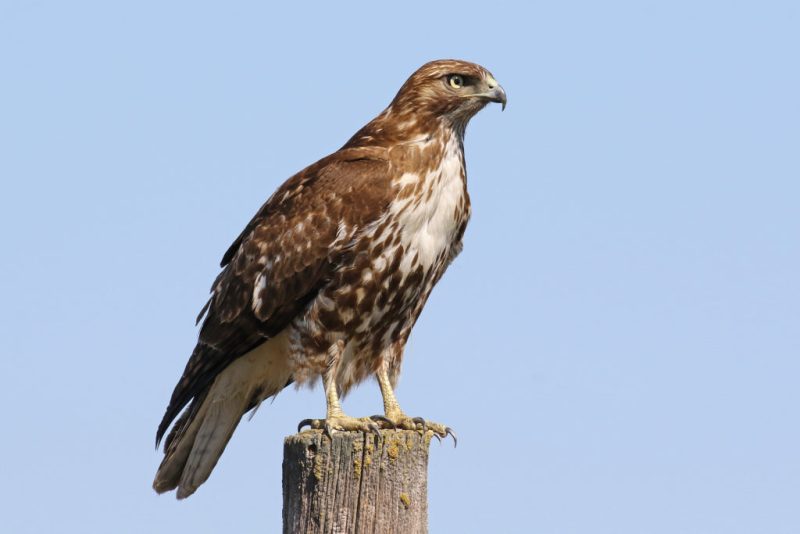
The Red-tailed Hawk is one of the most common and widespread raptors in Arizona. It is a large bird of prey, measuring 18–26 inches long with a wingspan of up to 4.5 feet. Adults are easily recognized by their broad, rounded wings and distinctive reddish tail, though their body plumage can vary from pale to dark brown.
This hawk is highly adaptable, found in deserts, grasslands, forests, and even city outskirts across Arizona. They are often seen soaring high in the sky or perched on utility poles, scanning for prey. Their diet includes small mammals, reptiles, birds, and carrion, making them opportunistic hunters.
A fun fact about the Red-tailed Hawk is that its piercing scream is one of the most familiar sounds in movies and television. Filmmakers often use the call of a Red-tailed Hawk as a dramatic “eagle scream,” even though eagles sound very different in reality.
Harris’s Hawk

The Harris’s Hawk is a striking raptor with chocolate-brown plumage, chestnut shoulders, and bold white markings on its rump and tail. This bird is medium to large in size, typically measuring 18 to 23 inches long with a wingspan of up to 4 feet. It has long yellow legs and a powerful hooked beak, making it easy to identify in the Arizona desert. Unlike many raptors, it is often seen perched in groups rather than alone.
Known for its cooperative hunting style, Harris’s Hawks are one of the few birds of prey that hunt in packs. They work together to flush out prey such as rabbits, rodents, and even other birds. Their teamwork allows them to take down larger prey that a single hawk could not manage on its own. This unique behavior sets them apart from most other raptors in North America.
In Arizona, Harris’s Hawks are most often found in the Sonoran Desert, nesting in tall cacti like saguaros or in mesquite trees. They adapt well to arid landscapes and can frequently be spotted soaring or perched on utility poles. A fun fact is that they are sometimes nicknamed the “wolves of the sky” because of their social hunting strategies.
Cooper’s Hawk
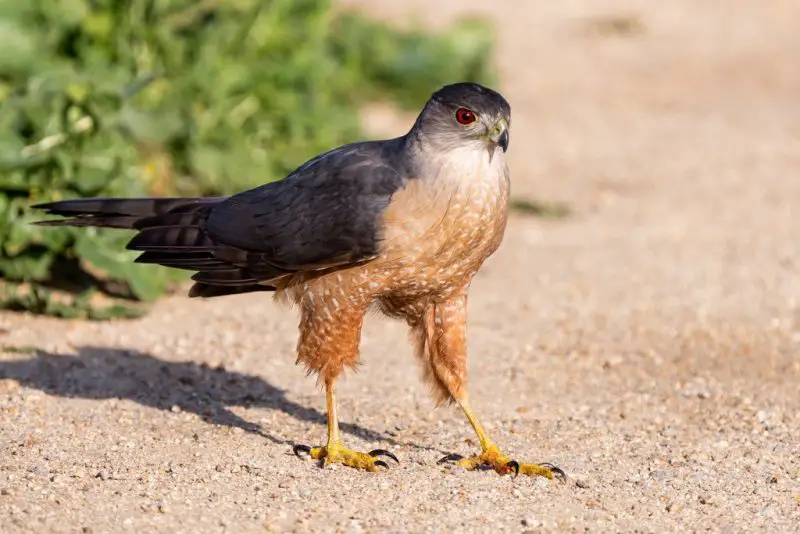
The Cooper’s Hawk is a sleek and agile bird of prey with a long, rounded tail and short wings built for maneuvering through trees. Adults display a bluish-gray back, reddish barring on the chest, and piercing red eyes. They are medium-sized hawks, usually measuring between 14 and 20 inches in length, with females being larger than males. Their appearance is often confused with the Sharp-shinned Hawk, but Cooper’s Hawks have a more rounded tail tip.
These hawks are masters of stealth and speed, relying on surprise attacks to catch their prey. Their diet mainly consists of smaller birds, such as doves, pigeons, and songbirds, as well as small mammals like squirrels. They are often seen darting quickly through wooded areas or chasing prey around bird feeders in suburban neighborhoods.
In Arizona, Cooper’s Hawks thrive in both natural and urban environments, from forests to desert oases and city parks. They are year-round residents of the state. A fun fact is that these hawks are among the most common raptors to visit backyard bird feeders—not for the seeds, but for the smaller birds that gather there.
Sharp-shinned Hawk
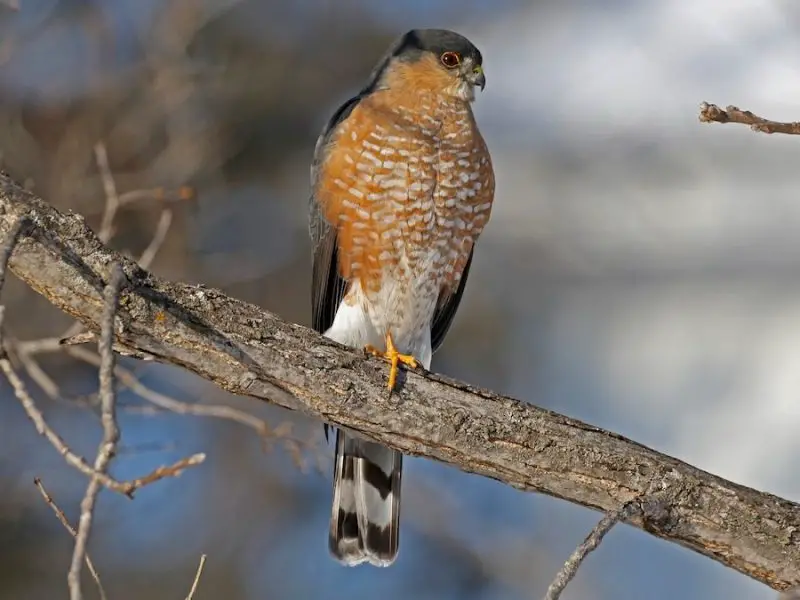
The Sharp-shinned Hawk is the smallest hawk in North America, measuring only 9 to 13 inches long with a wingspan of about 20 to 27 inches. It has short, rounded wings and a long, square-tipped tail that helps it maneuver swiftly through dense trees. Adults have bluish-gray backs with orange barring on the chest, while juveniles are brown with streaked underparts.
These hawks are agile hunters that specialize in preying on small songbirds. They wait in concealed perches before launching fast, surprise attacks. Because of their size and speed, they can weave through dense branches with remarkable skill. Although smaller than Cooper’s Hawks, they share similar hunting styles, often ambushing flocks of birds.
In Arizona, Sharp-shinned Hawks are mostly seen during migration and winter months. They prefer forested areas, but they also appear in urban settings when following prey. A fun fact is that despite their small size, Sharp-shinned Hawks are fierce predators, capable of taking down birds almost as large as themselves.
American Kestrel
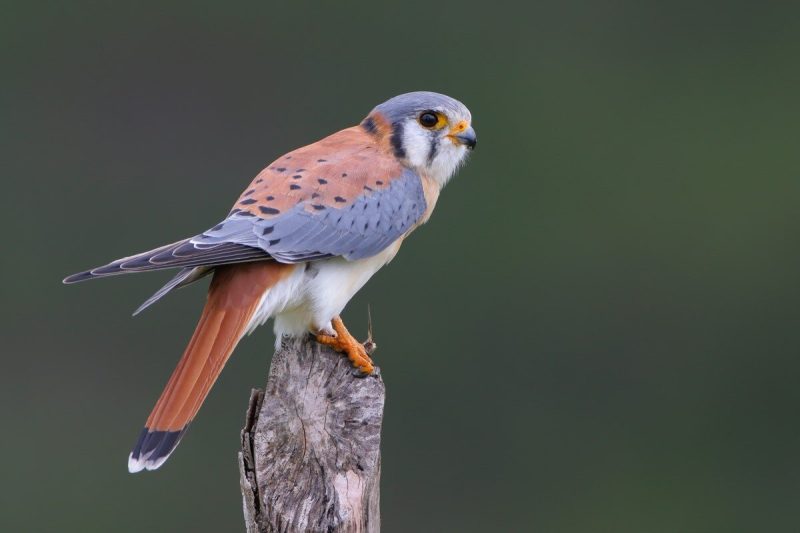
The American Kestrel is the smallest falcon in North America, but it is one of the most colorful and easily recognized. Males display blue-gray wings, a rusty back, and a spotted chest, while females are more reddish-brown overall. Both sexes have bold black facial markings that resemble a mustache. Measuring about 9 to 12 inches in length with a wingspan of around 20 inches, they are compact but striking raptors.
Unlike larger hawks, American Kestrels rely on hovering flight to spot prey in open areas. They primarily feed on insects, small rodents, lizards, and sometimes small birds. Their hunting style often involves perching on a wire or fence post before diving swiftly onto their prey. Despite their small size, they are bold and efficient hunters.
In Arizona, American Kestrels are widespread across deserts, grasslands, farmlands, and even urban areas. They nest in cavities, such as old woodpecker holes or nest boxes. A fun fact is that kestrels can see ultraviolet light, which helps them detect the urine trails of small mammals when hunting.
Peregrine Falcon
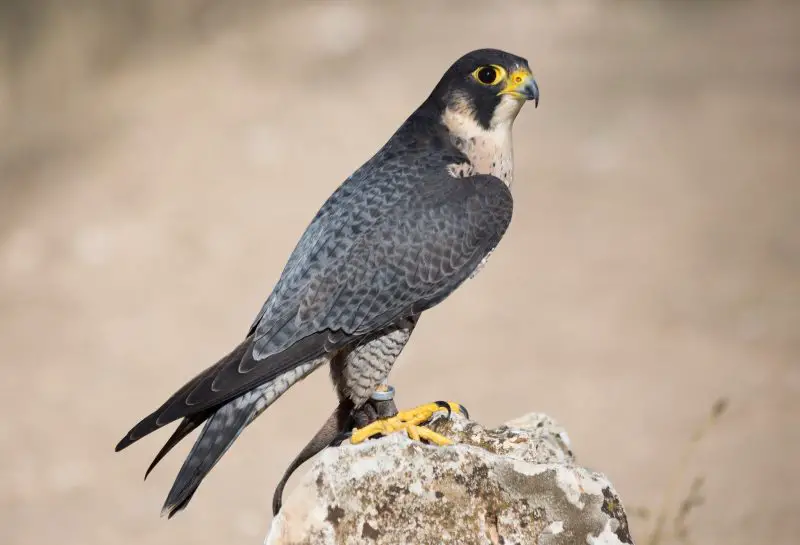
The Peregrine Falcon is famous for being the fastest animal on earth, capable of reaching speeds over 200 miles per hour during its hunting stoop. It has a sleek body, long pointed wings, and a strong hooked beak. Adults have blue-gray backs, barred underparts, and a distinctive dark hood with a black mustache mark. They measure 14 to 19 inches in length with wingspans up to 43 inches.
This falcon hunts primarily birds, which it captures in mid-air with astonishing speed and precision. Pigeons, doves, and waterfowl make up much of its diet. Peregrines rely on high perches, such as cliffs or tall buildings, to launch their dives. Their incredible vision and speed make them nearly unbeatable hunters.
In Arizona, Peregrine Falcons are found in both natural cliffs and urban environments, where they nest on tall skyscrapers. They are year-round residents in some areas but also migrate through the state. A fun fact is that peregrines were once endangered due to pesticide use, but conservation efforts have helped them make a strong comeback.
Turkey Vulture

The Turkey Vulture is a large scavenger easily identified by its dark body, broad wings, and featherless red head. It has a wingspan of nearly 6 feet, making it one of the largest soaring birds in Arizona. When flying, it holds its wings in a shallow V-shape and often wobbles from side to side, which is a key field mark.
These vultures play an important role in the ecosystem by feeding on carrion. Unlike raptors that hunt live prey, Turkey Vultures rely on their excellent sense of smell to locate dead animals, sometimes from miles away. Their strong stomach acids allow them to safely digest decaying meat that would be harmful to other animals.
In Arizona, Turkey Vultures are common in deserts, mountains, and open areas. They are often seen circling in groups high in the sky, riding thermal air currents. A fun fact is that vultures will sometimes spread their wings in the sun, a behavior called “sunning,” which helps them regulate body temperature and kill bacteria on their feathers.
Common Raven
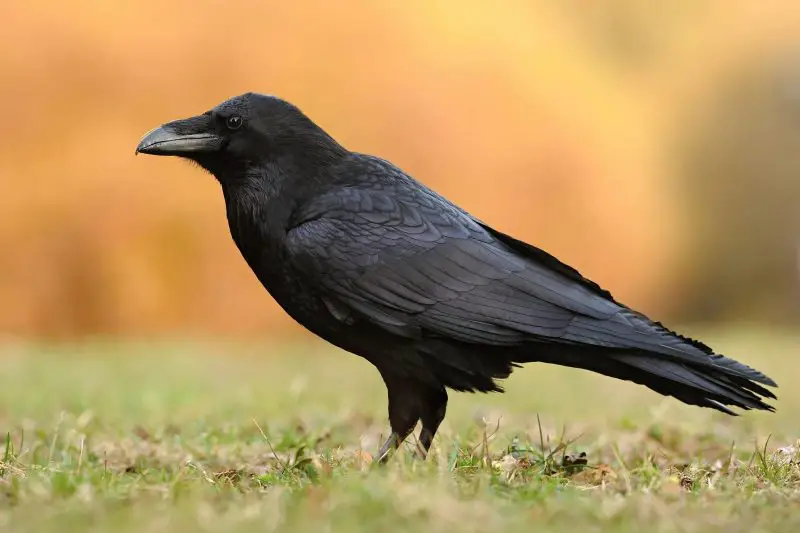
The Common Raven is one of the largest songbirds in North America, measuring 21 to 27 inches in length with a wingspan of up to 4.5 feet. It has glossy black plumage that can show iridescent hints of blue or purple in sunlight, a heavy bill, and a wedge-shaped tail. Ravens are often mistaken for crows, but their larger size and distinctive throat feathers, which look shaggy, help in identification.
Highly intelligent, Common Ravens are known for their problem-solving skills, playful behavior, and ability to mimic sounds. They feed on a wide variety of food, including carrion, small animals, insects, seeds, and even garbage in urban areas. Ravens are also social, often seen flying in pairs and performing aerial acrobatics.
In Arizona, Common Ravens thrive in deserts, mountains, and even urban landscapes. They are year-round residents across the state and adapt easily to different environments. A fun fact is that ravens are among the few birds known to use tools, such as sticks, to obtain food.
American Crow
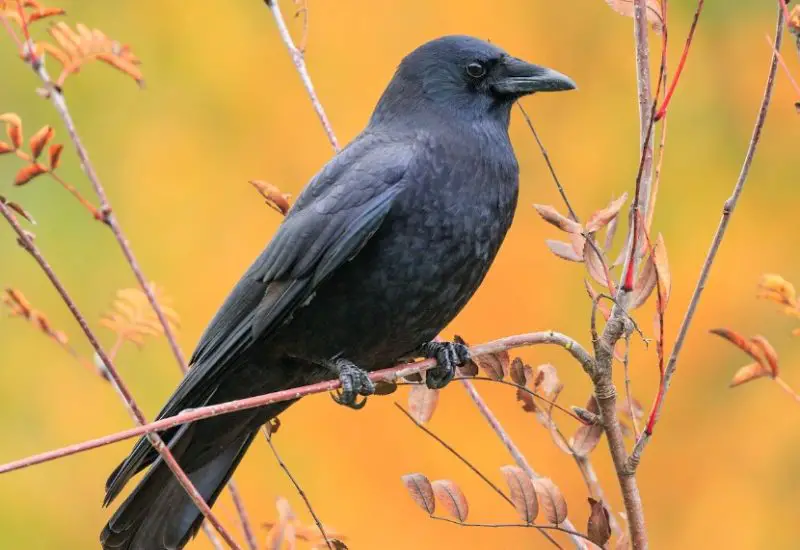
The American Crow is smaller than the raven, measuring 16 to 20 inches long with a wingspan of about 3 feet. Its plumage is completely black, including the bill and legs, but it has a more squared tail compared to the raven’s wedge-shaped tail. Its cawing call is one of the most recognizable bird sounds in North America.
Crows are omnivores with a highly adaptable diet that includes insects, seeds, fruits, small animals, and carrion. They are intelligent birds known for caching food, using problem-solving strategies, and working together in groups. Their social nature makes them successful in both rural and urban habitats.
In Arizona, American Crows are most commonly found in agricultural fields, open woodlands, and city areas. They are more abundant in northern Arizona than in the southern desert regions. A fun fact is that crows are capable of recognizing human faces and can remember people who have treated them kindly—or poorly.
Chihuahuan Raven
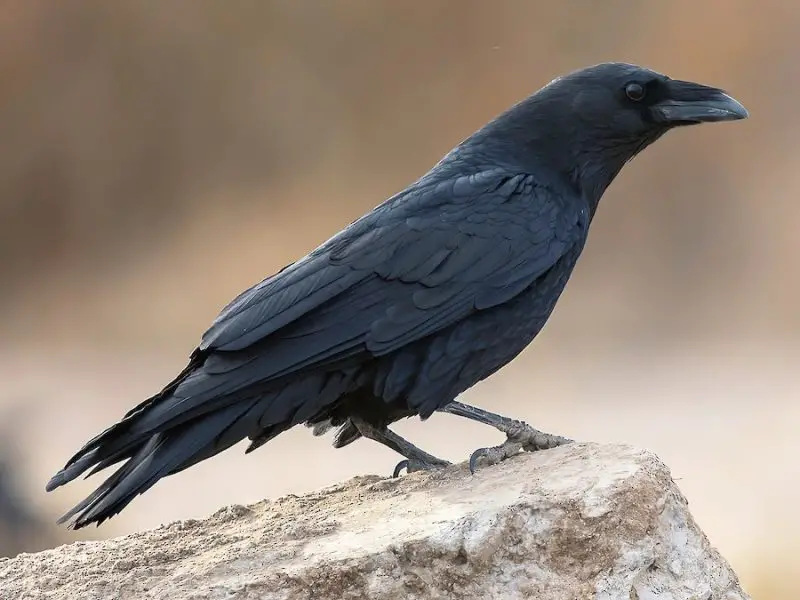
The Chihuahuan Raven closely resembles the American Crow but has subtle differences. It measures 18 to 20 inches in length with a wingspan of about 3.5 feet. Its plumage is glossy black, and in bright sunlight, its feathers often show a purple sheen. Unlike ravens, it has a smaller bill and a rounded tail. A key feature is the presence of white bases on its neck feathers, though this is hard to see without close observation.
These ravens feed mainly on insects, grains, small mammals, and carrion. They are often seen in flocks and can adapt to agricultural areas where food is abundant. Their call is a deeper croaking sound compared to the caw of crows.
In Arizona, Chihuahuan Ravens are found mostly in the southeastern parts of the state, where desert grasslands and open scrublands provide ideal habitats. A fun fact is that despite their resemblance to crows, Chihuahuan Ravens are more closely related to the Common Raven.
Black Phoebe
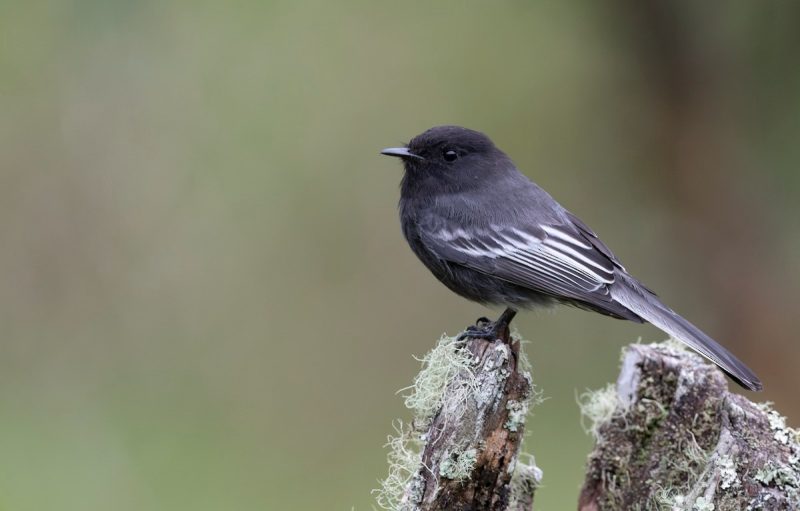
The Black Phoebe is a small, elegant flycatcher with striking black plumage on its head, chest, and back, contrasted by a clean white belly. Measuring about 6 to 7 inches in length with a wingspan of around 11 inches, it is a compact bird with a slightly rounded tail. Its constant tail-wagging behavior is a helpful clue for identification.
Black Phoebes primarily feed on insects, which they catch in mid-air or pick from the ground and water surfaces. They often hunt from perches near water, making quick flights to grab prey before returning to the same spot. Their sharp, two-syllable “pee-wee” call is a common sound in their habitat.
In Arizona, Black Phoebes are most often found near rivers, lakes, ponds, and backyard fountains. They are year-round residents in the state’s lower elevations. A fun fact is that Black Phoebes are strongly tied to water and are almost never found far from it.
Say’s Phoebe
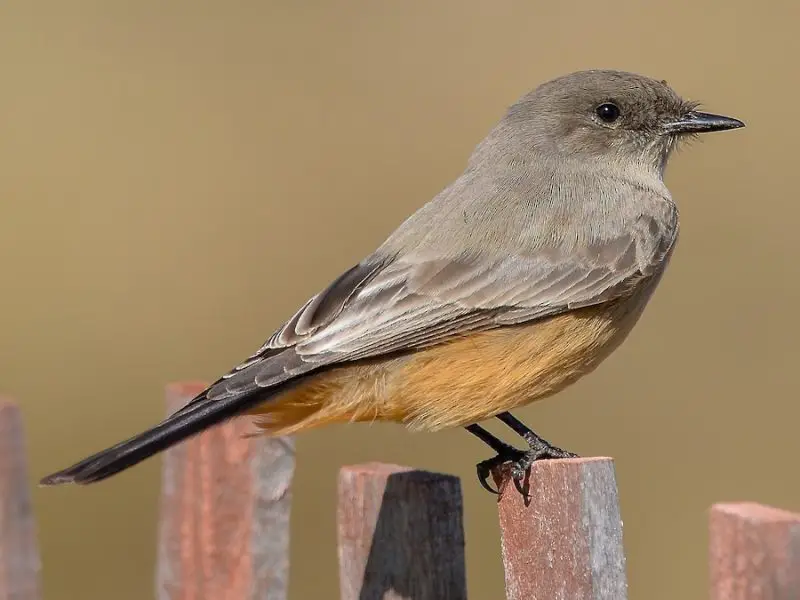
Say’s Phoebe is another flycatcher, slightly larger than the Black Phoebe, measuring 7 to 8 inches long with a wingspan of about 13 inches. It has a grayish-brown head and back, a pale gray chest, and a warm cinnamon-colored belly. Unlike the darker Black Phoebe, its overall coloring is more subtle and earthy.
Say’s Phoebes feed mainly on insects, such as grasshoppers, flies, and beetles, which they catch in flight or by swooping down from perches. They often hover briefly while hunting, a behavior not commonly seen in Black Phoebes. Their song is a soft, plaintive whistle that echoes across open landscapes.
In Arizona, Say’s Phoebes are commonly found in open deserts, grasslands, and agricultural areas. They often nest on man-made structures such as barns, bridges, and houses. A fun fact is that Say’s Phoebes are one of the few flycatchers that breed in arid desert regions where other species avoid.
Vermilion Flycatcher
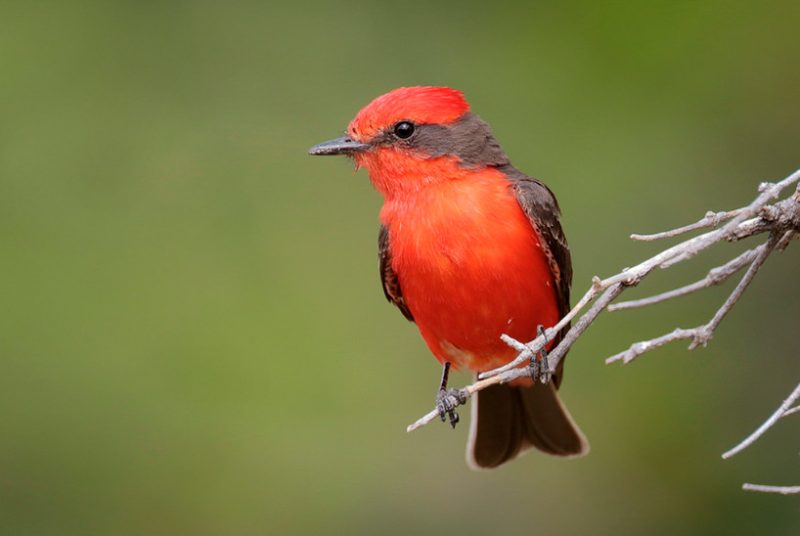
The Vermilion Flycatcher is one of Arizona’s most dazzling birds. Males are unmistakable with their brilliant scarlet-red plumage contrasted against dark brown wings and back. Females, while less colorful, display a soft peachy belly and grayish upperparts. They are small birds, measuring about 6 inches long with a wingspan of around 10 inches.
These flycatchers feed on insects, often darting out from exposed perches to snatch prey in mid-air. They frequently return to the same perch, making them easy to spot when actively foraging. Males are also known for their courtship displays, flying in circles above females while singing and showing off their vibrant plumage.
In Arizona, Vermilion Flycatchers are found in desert scrublands, riparian areas, and open fields. They are especially common in southern parts of the state. A fun fact is that despite their small size, these birds are highly territorial and will aggressively defend their space from other flycatchers.
Ash-throated Flycatcher
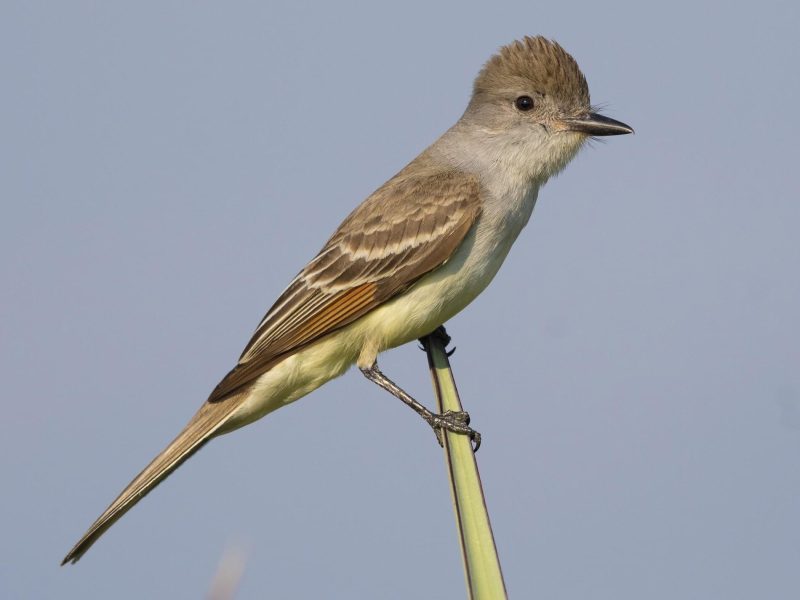
The Ash-throated Flycatcher is a medium-sized bird measuring about 8 to 9 inches in length with a wingspan of 12 to 13 inches. It has a grayish head and chest, pale throat, and warm cinnamon undertones in its wings and tail. Its overall muted plumage makes it less flashy than other flycatchers, but it is still easy to recognize thanks to its upright posture and loud calls.
This bird is an insect hunter, often seen perched on branches before making quick flights to snatch prey mid-air. While insects make up most of its diet, it also eats berries and small fruits when available. Ash-throated Flycatchers are cavity nesters, often using old woodpecker holes or even nest boxes.
In Arizona, they are commonly found in desert scrub, open woodlands, and riparian areas. They migrate south in winter but are abundant during the breeding season. A fun fact is that Ash-throated Flycatchers sometimes decorate their nests with snake skins, a behavior thought to deter predators.
Western Kingbird
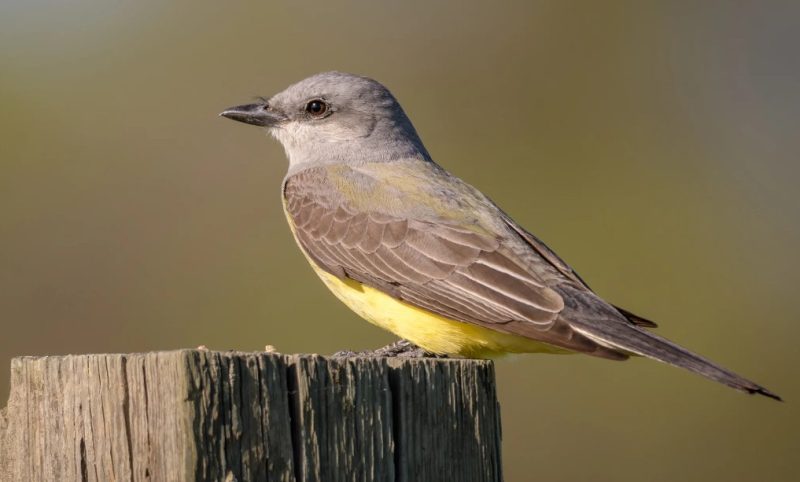
The Western Kingbird is a striking bird with a pale gray head and chest, bright yellow belly, and a black tail tipped with white. Measuring about 8 to 9 inches long with a wingspan of 15 inches, it is a bold and energetic species that often perches on wires, fences, or open branches in plain view.
Western Kingbirds are aggressive insect hunters and are known for their fearless nature. They frequently chase away larger birds, including hawks and crows, from their nesting territories. Their diet consists mostly of flying insects, but they also eat berries in late summer and fall.
In Arizona, they are most common during spring and summer, especially in open habitats such as grasslands, agricultural areas, and desert edges. A fun fact is that their name “kingbird” comes from their habit of attacking much larger birds that enter their territory.
Cassin’s Kingbird

Cassin’s Kingbird is similar in size and shape to the Western Kingbird, but it has a darker gray head and chest, a bold white throat, and a yellow belly. Measuring about 9 inches long with a wingspan of 15 inches, it has a more robust appearance. Its dark tail is edged with pale tips, which helps distinguish it from its cousin.
Like other kingbirds, Cassin’s Kingbirds are aerial hunters that feed on insects. They launch from perches with swift flights to grab prey in mid-air, returning to the same perch repeatedly. They are also territorial and can be quite vocal, producing sharp, chattering calls.
In Arizona, they are most often found in open woodlands, desert grasslands, and riparian corridors. They are summer residents and migrate south in winter. A fun fact is that Cassin’s Kingbirds sometimes perform dramatic aerial displays during courtship, including dives and fluttering flights.
Yellow-rumped Warbler
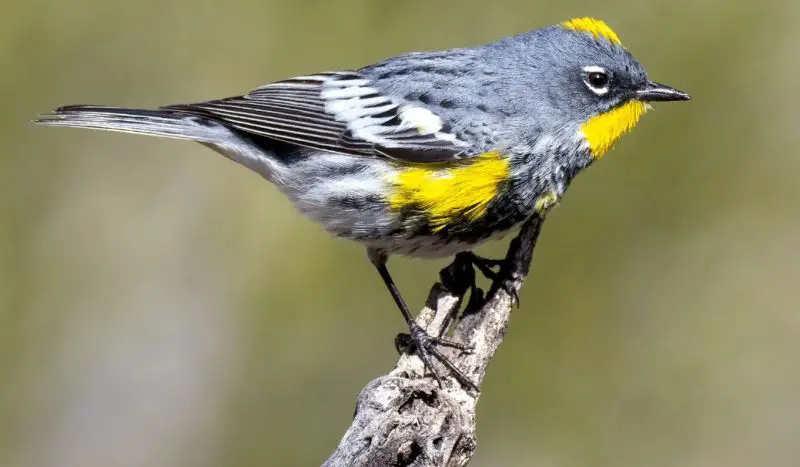
The Yellow-rumped Warbler is a small but colorful bird, measuring about 5 to 6 inches in length with a wingspan of 9 inches. Its most distinctive feature is the bright yellow patch on its rump, along with yellow sides and sometimes a yellow crown. The rest of its plumage varies by season, with males in breeding plumage showing bold streaks of black, white, and gray.
This warbler feeds on insects during the warmer months but has a unique ability to digest waxes in berries, allowing it to survive on fruits like bayberries in winter. Its adaptability makes it one of the most widespread warblers in North America.
In Arizona, Yellow-rumped Warblers are common during migration and winter, often found in forests, scrublands, and urban parks. A fun fact is that birdwatchers sometimes call them “butter butts” because of their bright yellow rump patch.
Lucy’s Warbler

Lucy’s Warbler is one of the smallest warblers in North America, measuring only 4.5 inches long with a wingspan of about 6 inches. It has soft gray plumage, a pale belly, and a subtle reddish crown patch that can be hard to see. Its small size and active foraging habits make it a lively presence in desert habitats.
This warbler feeds primarily on insects, gleaning them from foliage or catching them mid-air. Unlike many warblers, Lucy’s Warbler nests in cavities, often using old woodpecker holes or crevices in mesquite trees. They may even use nest boxes placed by humans in suitable areas.
In Arizona, Lucy’s Warblers are most commonly found in desert riparian areas and mesquite bosques, especially in the southern part of the state. A fun fact is that they are one of the very few warblers adapted to live in desert environments.
Abert’s Towhee
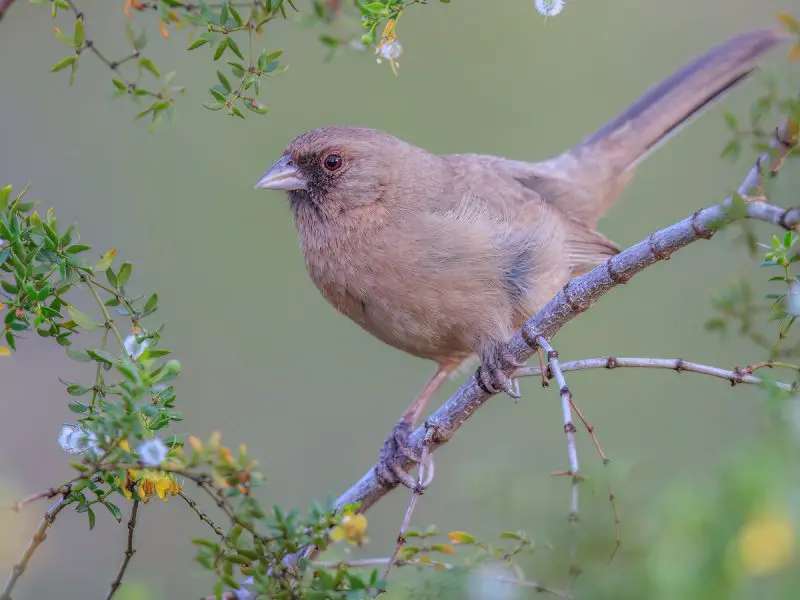
Abert’s Towhee is a large sparrow-like bird, about 8 to 9 inches long with a wingspan of around 11 inches. It has plain brown plumage overall, with a slightly darker face and a long tail. Though not flashy in color, its size and behavior make it easy to recognize in the right habitat.
These towhees forage mostly on the ground, scratching through leaf litter in search of insects, seeds, and berries. They are usually seen in pairs or small groups, staying low and hidden in dense brush. Their song is a series of sharp notes that can often be heard even if the bird is not visible.
In Arizona, Abert’s Towhees are residents of desert riparian habitats, especially areas with mesquite and willows. They are unique to the desert Southwest, with most of their range centered in Arizona. A fun fact is that Abert’s Towhees often mate for life and defend their territories year-round.
Canyon Towhee
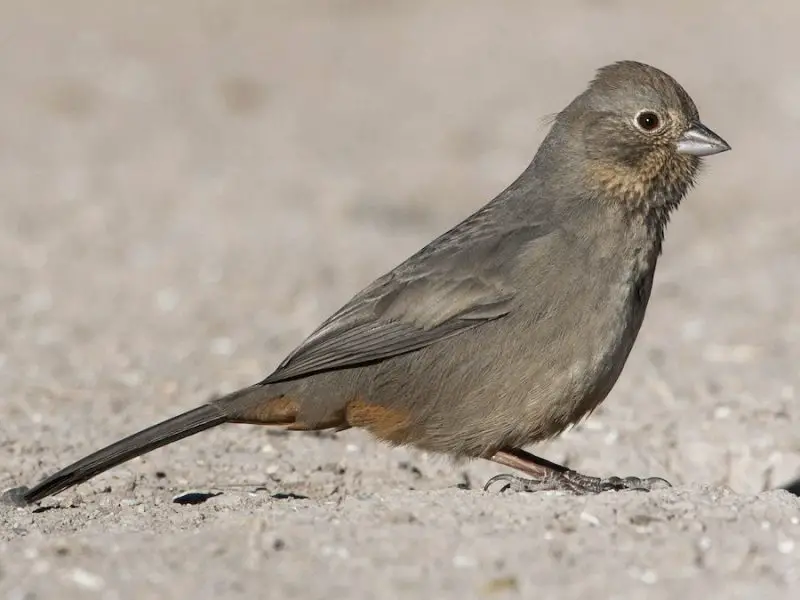
The Canyon Towhee is a medium-sized sparrow-like bird, measuring around 8 to 9 inches long with a wingspan of about 11 inches. It has plain brown plumage overall, a slightly grayer chest, and a subtle rusty crown patch that is sometimes visible. Its long tail and simple, unmarked appearance make it look understated, but it blends well into the desert landscapes of Arizona.
These towhees spend most of their time on the ground, scratching through dirt and leaf litter in search of seeds, insects, and berries. They are not as shy as some related species and are often seen foraging near homes, parks, and even patios in desert towns. Their call is a sharp, metallic “cheep,” while their song is a simple, repeated phrase.
In Arizona, Canyon Towhees are year-round residents, especially common in desert scrub, foothills, and open woodlands. They are also frequent visitors to backyards with ground seed feeders. A fun fact is that Canyon Towhees often run rather than fly when disturbed, darting quickly into cover.
Rufous-crowned Sparrow

The Rufous-crowned Sparrow is a small, attractive sparrow, measuring about 5 to 6 inches long with a wingspan of around 8 inches. Its most distinctive feature is the rusty-red crown, paired with a gray face marked by thin dark stripes. The rest of its plumage is brownish-gray, with fine streaking on the back that helps it blend into rocky terrain.
This sparrow feeds mainly on seeds and insects, foraging low in grasses or rocky areas. It is more often heard than seen, producing a sweet, trilling song that carries across the hillsides. Unlike some sparrows that form large flocks, Rufous-crowned Sparrows are usually seen in pairs or small family groups.
In Arizona, they prefer rocky slopes, canyons, and desert hillsides with scattered vegetation. They are year-round residents and are especially common in southern and central Arizona. A fun fact is that Rufous-crowned Sparrows are known to run swiftly across the ground, much like quail, when evading predators.
White-crowned Sparrow
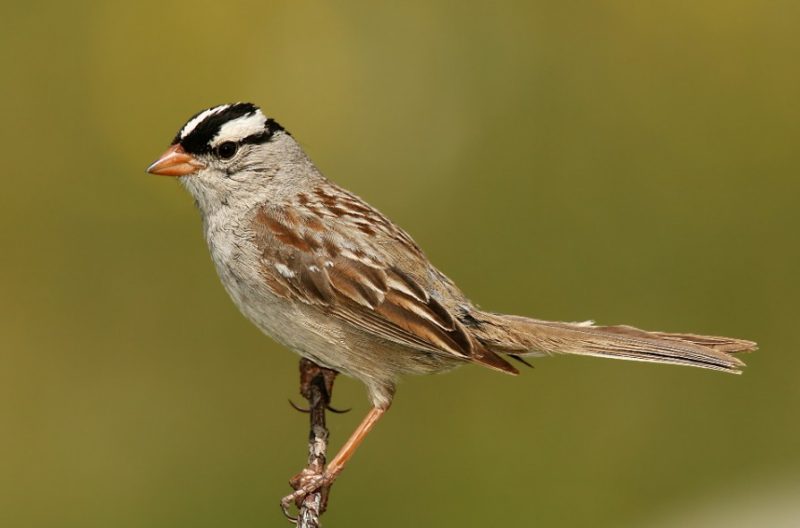
The White-crowned Sparrow is one of the most easily recognized sparrows in North America, thanks to its bold black-and-white striped crown. Adults have grayish bodies with brown wings streaked in black, and they measure about 6 to 7 inches in length with a wingspan of 9 to 10 inches. Juveniles look different, with brown-and-tan head stripes instead of black-and-white.
These sparrows feed on seeds, insects, and small fruits, foraging mostly on the ground or in low shrubs. Their clear, whistled song is a familiar sound in many habitats during migration. They are also social birds, often seen in mixed flocks during the winter months.
In Arizona, White-crowned Sparrows are common winter visitors, especially in desert valleys, open fields, and residential areas. They migrate north to breed in the summer. A fun fact is that different populations of White-crowned Sparrows have regional dialects in their songs, much like human accents.
Song Sparrow

The Song Sparrow is a medium-sized sparrow measuring 5 to 7 inches long with a wingspan of about 9 inches. Its plumage is brown and heavily streaked, with a distinct dark spot in the center of its chest. This feature, along with its long tail and streaky appearance, helps in distinguishing it from other sparrows.
True to its name, the Song Sparrow is well-known for its musical and variable song, often described as a series of sweet, whistled notes mixed with trills. It feeds on seeds and insects, foraging close to the ground in brushy areas or along water edges. Its adaptability allows it to thrive in both wild and suburban landscapes.
In Arizona, Song Sparrows are most often found in riparian habitats, marshes, and areas with dense vegetation near water. They are year-round residents in parts of the state, though more common in winter. A fun fact is that Song Sparrows can have highly localized song variations, with males tailoring their songs to stand out in their specific environment.
FAQs About Common Birds of Arizona
What are the most common backyard birds in Arizona?
Arizona backyards often host Northern Cardinals, House Finches, Mourning Doves, White-winged Doves, and Gambel’s Quail. These birds adapt well to human environments, taking advantage of feeders, birdbaths, and native plants.
When is the best time to observe hummingbirds in Arizona?
The best time to see hummingbirds like Anna’s, Costa’s, Broad-billed, and Black-chinned is from late winter through early fall. Many species migrate through Arizona, while others, such as Anna’s Hummingbird, stay year-round, especially around flowering plants and feeders.
Where can I spot owls in Arizona?
Great Horned Owls, Western Screech-Owls, Elf Owls, and Burrowing Owls are typically observed at dusk or night. Great Horned and Western Screech-Owls prefer forests and riparian areas, Elf Owls inhabit desert cacti, and Burrowing Owls are found in open deserts and grasslands near burrows.
What do hawks and falcons eat in Arizona?
Red-tailed Hawks, Cooper’s Hawks, Sharp-shinned Hawks, Harris’s Hawks, American Kestrels, and Peregrine Falcons primarily hunt small mammals, birds, reptiles, and insects. Peregrine Falcons are specialized aerial hunters, while Kestrels often hover to spot prey in open areas.
How can I distinguish between ravens and crows?
Common Ravens are larger (21–27 inches), with wedge-shaped tails and shaggy throat feathers, whereas American Crows are smaller (16–20 inches) with squared tails and smoother throat feathers. Chihuahuan Ravens are intermediate in size and mostly found in southeastern Arizona.
Which flycatchers are common in Arizona deserts?
Ash-throated Flycatchers, Black Phoebes, Say’s Phoebes, and Vermilion Flycatchers are frequently observed in desert scrub, riparian areas, and open fields. They primarily feed on insects and are often seen perched prominently before darting to catch prey mid-air.
Are there warblers that live in Arizona year-round?
Most warblers, like Yellow-rumped and Lucy’s Warblers, are seasonal visitors. Lucy’s Warbler is unique because it breeds in desert riparian areas and is adapted to Arizona’s dry habitats, while Yellow-rumped Warblers are more common during migration and winter.
What sparrows can be seen in Arizona?
Common sparrows include Abert’s Towhee, Canyon Towhee, Rufous-crowned Sparrow, White-crowned Sparrow, and Song Sparrow. They occupy desert scrub, riparian zones, and foothills, foraging on seeds, insects, and berries, often on or near the ground.
Can Arizona birds be attracted to feeders?
Yes, many species are attracted to feeders. House Finches, Northern Cardinals, hummingbirds, and some sparrows readily visit feeders with seeds or nectar. Providing native plants and water sources also increases sightings of local birds.
Are any of these birds unique to Arizona?
Some species, such as Abert’s Towhee and Lucy’s Warbler, are closely tied to the desert Southwest, with most of their populations centered in Arizona and neighboring states. Other birds are widespread but adapt remarkably well to Arizona’s varied habitats.





